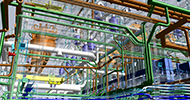In the previous blog of this series, we discussed the crucial role big data is playing in Industry 4.0. Here, we will explore the role of the internet of things (IoT) and how it is disrupting and transforming the world of manufacturing.
What is IoT?
IoT is the connection of machines, sensors and devices to the internet, to enable the collection of real-time information on the status and functioning parameters of your manufacturing lines, processes and products.
These applications share and gather information automatically (and much quicker than if human intervention were required).
This online interconnectivity provides manufacturers with new levels of efficiency, with instant access to the data needed for smarter decision-making.
IoT – an opportunity for manufacturing
IoT gives rise to a host of manufacturing opportunities that can streamline efficiency and boost productivity.
Readily available real-time data brings instant transparency to the entire production process through performance and condition monitoring. It also gives you much faster and more informed insights into new and potential production issues.
By applying analytics to your production data, it is possible to reveal the optimal parameters for production processes so that the inputs and variables can be set for optimal outputs, meaning less wastage and faster production.
What about IoT security?
As with a number of technology systems, cyber risk should be carefully considered.
Defensive technologies and processes are evolving fast and all IoT players, from users to manufacturers, are working to address this concern. One good approach is to embed several layers of security to your cloud-connected machines, to protect from cyber attacks. But, more positively, cloud connectivity helps ensure your shop-floor machines are safe to run.
As in many industries, cyber threats and data loss can originate internally, as much through error, bad practice or misunderstanding, as through malice. Ensuring you have the correct knowledge, training and awareness of risks is a fundamental pillar of a comprehensive cyber and data security strategy for IoT.
Where to start with IoT
It makes sense to start with a small and relatively low-risk production process rather than overhauling your whole factory so that teething problems can be identified with minimal risk. Switching to cloud computing is an enabler of working with IoT. Find out more in this video with Diego Tamburini, Microsoft’s Senior Industry Strategist for Design and Manufacturing, and see how Hexagon are working in partnership with Microsoft to help utilise cloud computing in manufacturing environments.
An essential early step would be to transition your paper-based records to electronic. At the same time, seek to increase the amount of metrics you collect, imposing more measurements, analysing more results, and implementing controls or inline measurements. This step of utilising big data is critical in facilitating your move to greater interconnectivity.
The next step would be to transition data to the cloud and run the process for a few months to gain familiarity with the procedure and reflect on what you learn.
Collate and analyse your data, identifying areas for improvement and possible problems. Use the large data volume to more accurately identify patterns and common issues. Could the tool have been changed? How do the discrepancies relate to other environmental data? Is your product quality constant or erratic? The interconnectivity of IoT can be a game-changer for addressing the problems at the root of questions like these.
Making data your focus
Focusing on measuring and analysing progress in every step of the process will be beneficial. With IoT connectivity supporting integration of quality management systems and production systems, increased visibility of data will support new levels of efficiency and accuracy.
In the next decade you’re likely to see a boom in device connectivity and real-time data usage in manufacturing. The key to implementing this is to use and measure data optimally, by creating the right platforms and allowing the right decisions to be taken at the right time.
As internet of things platforms become more commonplace, your attention should shift to data, as other users begin to interact with the production process in a very different way. As this happens, your focus on data, metrics and insights will drive change and support continuous improvement.
The next and final blog in this series will look at how to develop and benefit from the Smart Factory.














